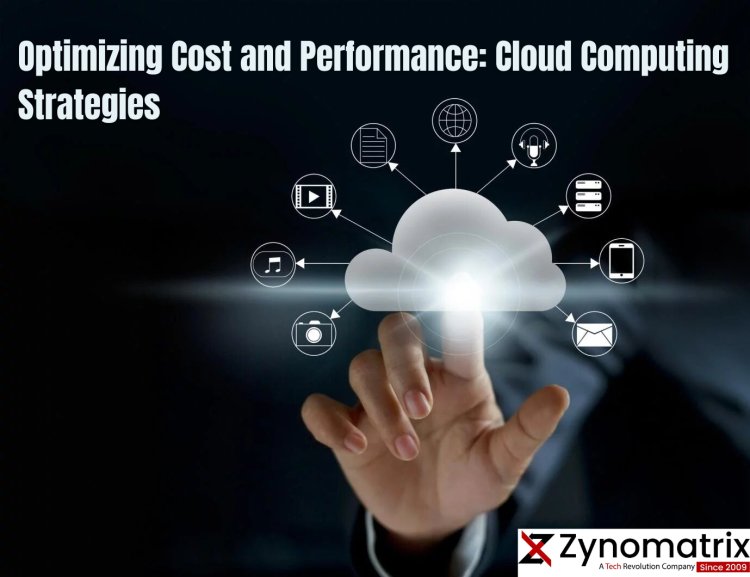Optimizing Cost and Performance: Cloud Computing Strategies
Cloud computing has revolutionized the IT landscape, offering unprecedented scalability and agility. However, the flexibility of the cloud can come with increased costs if not managed effectively. Achieving the perfect equilibrium between cost efficiency and optimal performance is a complex task. In this blog post, we'll delve into cloud computing strategies that help you find that balance. From right-sizing resources and implementing cost-effective storage solutions to leveraging auto-scaling and optimizing data transfer costs, these strategies will empower you to make the most of your cloud investments.

Introduction:
In the realm of cloud computing, the ability to balance cost and performance is a critical skill. Cloud resources are incredibly powerful, but they come at a price. To make the most of the cloud's potential, you need a well-defined strategy that optimizes both cost and performance. In this blog post, we'll explore strategies to strike the right balance in the cloud. Whether you're an enterprise looking to reduce operational costs or a startup striving to achieve peak performance, these strategies will guide you on your journey to cost-efficient and high-performing cloud computing.
Optimizing Cost and Performance: Cloud Computing Strategies
In the realm of cloud computing, the ability to balance cost and performance is a critical skill. Cloud resources are incredibly powerful, but they come at a price. To make the most of the cloud's potential, you need a well-defined strategy that optimizes both cost and performance. In this blog post, we'll explore strategies to strike the right balance in the cloud. Whether you're an enterprise looking to reduce operational costs or a startup striving to achieve peak performance, these strategies will guide you on your journey to cost-efficient and high-performing cloud computing.
The Challenge of Cost and Performance in the Cloud
The cloud's dynamic nature allows you to allocate resources on demand, but this flexibility can lead to underutilized or oversubscribed resources, resulting in higher costs. Finding the right balance involves understanding your application's performance requirements and optimizing your cloud resources accordingly. It's about using the cloud's scalability to your advantage without breaking the bank.
Right-Sizing Your Resources
Right-sizing is a fundamental cost optimization strategy. It involves aligning your cloud resources with your actual needs. This means choosing the right instance types, storage solutions, and network configurations to avoid overprovisioning, which can be costly. Regularly assess your resource usage and adjust as necessary.
Leveraging Auto-Scaling
Auto-scaling is a game-changer for both performance and cost efficiency. It allows your infrastructure to automatically adjust based on real-time demand. When traffic spikes, resources scale up to handle the load, and when it drops, they scale down to save costs. Implementing auto-scaling policies ensures that you're always using the minimum necessary resources.
Cost-Effective Storage Solutions
Storage is a significant cost factor in the cloud. By choosing cost-effective storage options like object storage, and utilizing tiered storage for infrequently accessed data, you can optimize your cloud costs without sacrificing performance. Additionally, data compression and deduplication techniques can further reduce storage costs.
Optimizing Data Transfer Costs
Data transfer costs can be a hidden expense in the cloud. Strategically choose regions and availability zones, use Content Delivery Networks (CDNs), and optimize data transfer with compression and efficient protocols to minimize these costs. Data transfer optimization can lead to substantial savings, especially for data-intensive applications.
Continuous Monitoring and Cost Control
Cost optimization in the cloud is not a one-time effort; it's an ongoing process. Regularly monitor your resource usage and costs, analyze billing reports, and use cost management tools provided by your cloud provider. Implement cost controls to set budgets, alerts, and automated policies to ensure you stay within budget.
Balancing Cloud Costs and Performance
Optimizing cost and performance in the cloud is a dynamic endeavor. It requires a combination of right-sizing, auto-scaling, cost-effective storage, and data transfer optimization. By implementing these strategies and continuously monitoring and controlling costs, you can achieve a well-balanced and cost-efficient cloud infrastructure that meets your performance requirements without overspending. The cloud's vast potential is within reach, and with the right strategies, you can make the most of it.
What's Your Reaction?





















